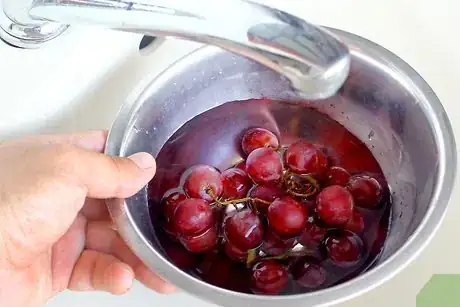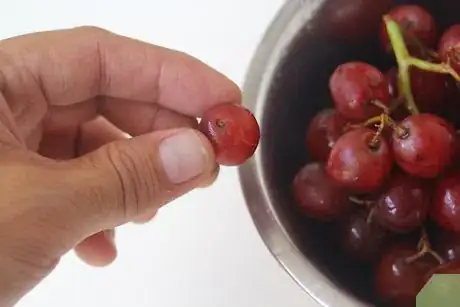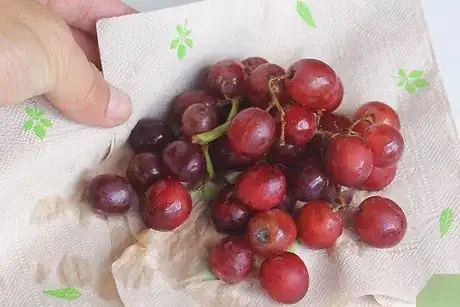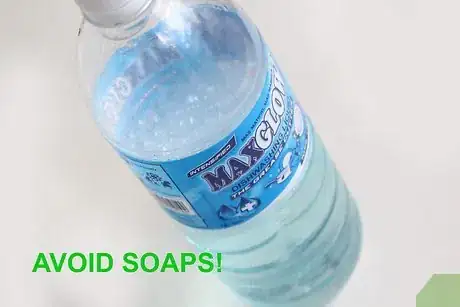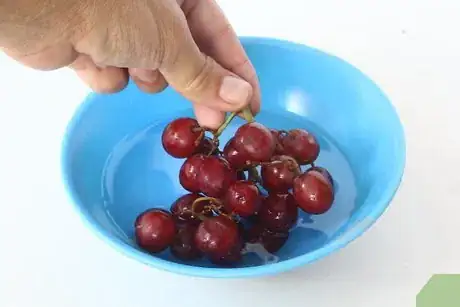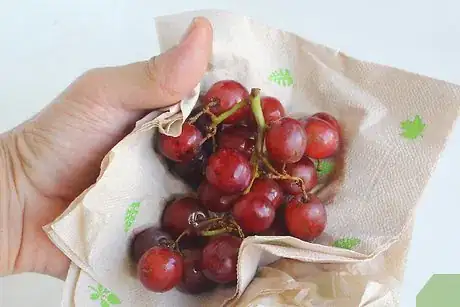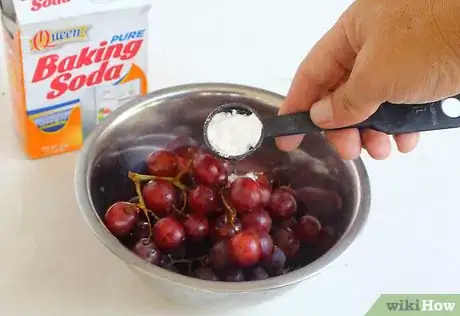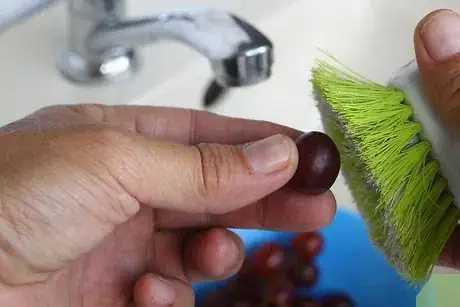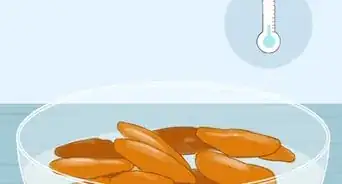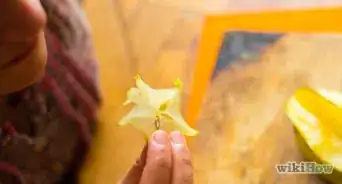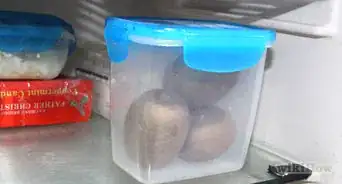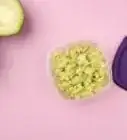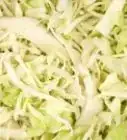This article was co-authored by wikiHow Staff. Our trained team of editors and researchers validate articles for accuracy and comprehensiveness. wikiHow's Content Management Team carefully monitors the work from our editorial staff to ensure that each article is backed by trusted research and meets our high quality standards.
There are 7 references cited in this article, which can be found at the bottom of the page.
wikiHow marks an article as reader-approved once it receives enough positive feedback. In this case, 88% of readers who voted found the article helpful, earning it our reader-approved status.
This article has been viewed 196,935 times.
Learn more...
Grapes are considered a member of the “Dirty Dozen.” These are types of produce that have the highest concentration of pesticides in them. In some cases, pesticides can linger on grapes, even after washing the fruit. This increases the risk of exposure to chemicals that are toxic to the brain and nervous system.[1] You can wash your grapes by using proper cleaning techniques with water or soaking them in vinegar and water.
Steps
Cleaning Your Grapes with Water
-
1Store your grapes unwashed. Wait to wash your grapes until you plan on using them. This can prevent extra moisture from speeding up the decay process. Keep the grapes in their original container.[2]
- Pull out servings of grapes as you need and then wash them.
-
2Rinse off your grapes. Pull out your desired serving of grapes. Hold them under cool, running water for thirty seconds. Rub them gently as you rinse.[3] This can remove around 85% of the bacteria. It also rinses off pesticides on the grapes.[4]
- Rinse the grapes by hand or place them in a colander.
Advertisement -
3Soak your grapes. Put your grapes into a clean bowl and place it in the sink. Run cool, clean water over the grapes until the water just covers them. Allow your grapes to soak for 5-10 minutes. This can remove bacteria and pesticides.[5]
- Avoid soaking your grapes in the sink. This can introduce bacteria onto them and may cause illness. If you don't have a bowl, clean and rinse your sink before soaking your grapes.
-
4Remove broken or decaying grapes. Check for any grapes that have broken skins or are decaying. Remove and throw them away. These may have bacteria, pesticide, or other residue you can't reach with cleaning.[6]
-
5Dry your grapes. Put your grapes on a clean towel or baking sheet covered with a clean towel. Let your grapes air dry for about ten minutes. Gently dry each grape with the towel before eating or using them to remove any lingering bacteria, pesticide, or waxy substance.[7]
-
6Avoid soaps. Steer clear of using any soaps or detergents on your grapes. These can leave a film on your grapes that is not safe for consumption and may cause illness or other reactions.[8]
Soaking Grapes in Vinegar and Water
-
1Mix a water and vinegar solution. In a clean bowl, pour three parts clean water. Add one part vinegar to the water. This is the most effective concentration to remove bacteria and pesticides.[9]
- Use water that is close to the temperature of the grapes.
-
2
-
3Rinse with water. Empty the vinegar and water solution from the bowl. Then rinse your grapes in cold, running water for thirty seconds. This can wash off any lingering bacteria or residue. It also removes the residual flavor of vinegar.[12]
-
4Let your grapes dry. Set your grapes on a clean dishtowel or a paper towel. Air dry them for about ten minutes before eating or storing them.[13]
Scrubbing Your Grapes
-
1Clear off grapes with baking soda and salt. Gently pull your grapes from the stem and rinse them under cool, running water in a clean bowl. Sprinkle 1-2 teaspoons each of salt and baking soda over the grapes. Shake the bowl vigorously from side to side for thirty seconds to a minute. Rinse again to remove the pesticides, bacteria, residue as well as the salt and baking soda.[14]
- Rub your hand lightly over the grapes as you rinse the second time to remove all traces of the baking soda and salt.
-
2Scrub with a produce brush. Get a brush specifically designed for washing produce. As you rinse with water or the water and vinegar solution, gently scrub each grape with the brush. This can clear away pesticides and other residue. It may also remove up to 85% of the bacteria on grapes.[15]
-
3Use caution if scrubbing. Grapes have very delicate skin that can break easily. If you plan to scrub your grapes with a brush or baking soda and salt mixture, use gentle pressure. This can remove bacteria, pesticides and other residue. It also ensures you don't harm the skin of your grapes.[16]
References
- ↑ https://www.ewg.org/foodnews/summary.php
- ↑ http://www.grapesfromcalifornia.com/home/storage-and-handling/
- ↑ http://www.grapesfromcalifornia.com/home/storage-and-handling/
- ↑ http://www.npr.org/templates/story/story.php?storyId=14540742
- ↑ https://www.bestfoodfacts.org/fruit-vinegar/
- ↑ http://modernfarmer.com/2015/01/7-myths-washing-produce/
- ↑ http://naturesnurtureblog.com/how-to-wash-grapes-the-right-way/
- ↑ http://www.npr.org/templates/story/story.php?storyId=14540742
- ↑ http://www.npr.org/templates/story/story.php?storyId=14540742
- ↑ https://www.bestfoodfacts.org/fruit-vinegar/
- ↑ http://www.npr.org/templates/story/story.php?storyId=14540742
- ↑ http://www.npr.org/templates/story/story.php?storyId=14540742
- ↑ http://naturesnurtureblog.com/how-to-wash-grapes-the-right-way/
- ↑ http://naturesnurtureblog.com/how-to-wash-grapes-the-right-way/
- ↑ http://www.npr.org/templates/story/story.php?storyId=14540742
- ↑ http://naturesnurtureblog.com/how-to-wash-grapes-the-right-way/
About This Article
To wash grapes, hold them under running water for 30 seconds, rubbing them gently as you rinse them off. Then, put your grapes in a clean bowl and fill the bowl with cool, clean water until the grapes are completely covered. Allow them to soak for 5-10 minutes in the water to get rid of pesticides and bacteria. If you want to remove 98% of bacteria, combine 3 parts vinegar to 1 part water and soak the grapes in that instead. Be sure to rinse the grapes off with clean water before you enjoy them! If you want to learn how to use a scrub brush on your grapes, keep reading the article!


